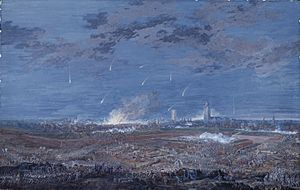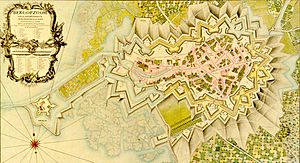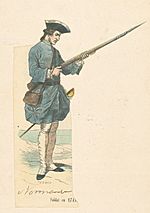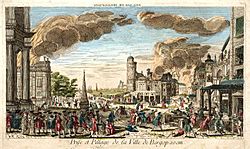Siege of Bergen op Zoom (1747) facts for kids
Quick facts for kids Siege of Bergen op Zoom |
|||||||
|---|---|---|---|---|---|---|---|
| Part of the War of the Austrian Succession | |||||||
 The assault on Bergen op Zoom |
|||||||
|
|||||||
| Belligerents | |||||||
| Commanders and leaders | |||||||
|
Count Löwendal | ||||||
| Strength | |||||||
| ~10,000-26,000 | ~30,000-35,000 | ||||||
| Casualties and losses | |||||||
|
5,000-6,000 5,500 killed or wounded 20,500 captured 293 guns |
4,269 killed and wounded, of which less than 500 in the final assault or 6,500 or 10,000 or 20,000 |
||||||
The siege of Bergen op Zoom happened during the War of the Austrian Succession. A French army, led by Count Löwendal, attacked and captured the important Dutch fortress of Bergen op Zoom. This happened in 1747, near the border of Brabant and Zeeland in the Dutch Republic. The fortress was defended by soldiers from the Netherlands, Austria, Britain, Hanover, and Hesse. They were all fighting to support the Pragmatic Sanction.
After seven years of tough war, both sides were very tired. Even though there were talks about peace, neither side wanted to give in yet. Capturing Bergen op Zoom would be a big defeat for the Dutch. It would also open the way for France to invade the Netherlands. Everyone in Europe watched the siege closely. People eagerly followed the news. The allies believed the fortress would hold, but the French were determined to take it.
Contents
Why was Bergen op Zoom important?
After winning the Battle of Lauffeld, French Marshal de Saxe sent 30,000 soldiers to attack Bergen op Zoom. This force was led by General von Lowendal, who was very skilled at sieges. Saxe thought his enemies would not be able to defend two cities at once. The British and Austrian commanders could not help Bergen op Zoom. They needed to protect Maastricht from Saxe's army.
Bergen op Zoom was a fortress town with about 5,000 people. It had an initial defense force of 3,000 soldiers. The commander was 86-year-old Governor General Cronström. The fortress walls were about three miles long. They had ten bastions and five hornworks. There were also twenty-one ravelins, protected by stone lunettes. Much of the land around it was marshy. The Dutch also flooded large areas to stop the French from getting close.
The fortress was designed by a famous Dutch engineer, Menno van Coehoorn. People believed it could not be captured. It was considered the strongest fort in Dutch Brabant. Bergen op Zoom had already survived two sieges before, in 1588 and 1622. It could get supplies by boat using two canals, each with its own fort. The fortress had plenty of soldiers and supplies. The Dutch navy could also bring supplies without much trouble from the French.
The Siege Begins
The fortress had over 230 cannon and mortars. The French focused their attack on the Coehoorn and Pucelle bastions. This area was chosen because the ground was drier. It was also the only part of the fortress not covered by extra defense lines. This part of the fort saw the most intense fighting.
Digging Trenches
On the night of July 14, the French started digging trenches. They used 2,400 workers and many soldiers. Lowendal used 12,000 of his troops to guard the trenches. Another 18,000 watched for enemy movements. The first trench line was dug on the first night, 400 paces from the fort. The second was dug on July 17, and the third on July 22.
The French built batteries and began firing cannons on July 20. They kept digging closer to the fortress. The fourth trench line was finished by July 28. A fifth was dug right up against the defenses by September 8. The French also dug mines under the defenses to blow them up. The Dutch dug their own counter-mines to stop them.
On July 25, a Scottish group called Loudon's Highlanders attacked a French battery. They destroyed it. Other British soldiers, engineers, and artillery joined the Dutch defense. Austrian miners also came to help.
Fighting for the Walls
After a month, the French reached the covered way, which was a protected path around the fort. But the Dutch still held several lunettes in the area. These forts fired on the French. The lunette Zealand was held by Hessian allies. The French used mines, attacks, and constant bombing to push the Dutch out. There were 75 mines set off during the fighting around the covered way.
After two months of hard fighting, the French could finally fire on the main wall. Saxe sent Lowendal 12,000 more soldiers because of heavy losses. The defenders also received more troops. On August 8, the allied army tried to break the siege. They attacked the French at night, but it was not well planned. The allies were pushed back. However, they kept bothering French supply convoys.
The Final Attack
Lowendal felt he needed to take the town quickly because autumn rains were coming. The rains would make the siege fail. Lowendal was told that parts of the fort's defenses were weak. So, he decided to storm the city in a surprise attack. This happened early on September 18, 1747. The Dutch commanders did not think the walls were weak enough. They had not taken extra precautions.
French soldiers, with workers to clear paths, got ready for each weak spot. At 4 a.m., a short bombardment was made. French Grenadiers quickly got into the fosse. They went through the weak spots and opened a sallyport (a small gate). This let the rest of the troops inside. They then took the gates and entered the city.
The commander, Cronström, and his officers were reportedly still asleep. Most of them were captured by the French. A Scottish group, Loudon's Highlanders, fought bravely in the streets. They made a stand in the market place. They lost many soldiers but helped Governor Cronström escape. The Dutch and their allies lost about 3,000 soldiers during the attack. The French lost only 479. About 200 fortress guns were captured. Seventeen supply ships in the port were also taken. After the city fell, the forts outside the city also surrendered.
After the city was taken, the French soldiers lost control. They caused damage and disorder in the town. Many civilians were affected. Lowendal expressed his regrets. However, people in Europe were very upset.
What happened next?
This siege was the longest and bloodiest of the war. The number of soldiers lost varies greatly. For the Allies, it was between 5,000 and 26,000. For the French, it was between 4,300 and 20,000. With Bergen op Zoom captured, the French now controlled the entire Scheldt river.
This defeat caused problems between the Dutch and British governments. The British realized they had asked too much of the Dutch Republic. The Dutch were very angry that their allies did not help them more. Bergen op Zoom was key to protecting the Dutch Republic and Hanover from a French invasion. Lowendal was made a Marshal of France for his success. This defeat, along with the Battle of Lauffeld, made the British more serious about peace talks. This led to a treaty in 1748.









